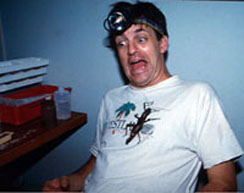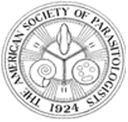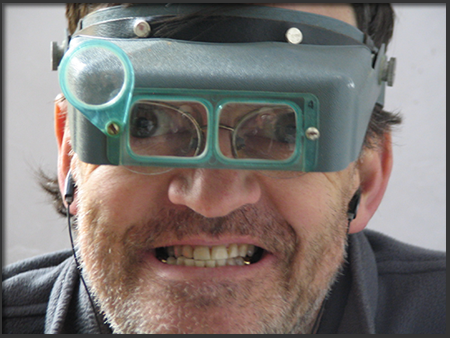

I have been interested in host-parasite relationships since I was in high school, which is a little frightening. Even more frightening is the fact that part of my Ph.D. thesis research was related to the topic of a high school science fair project (impact of parasites on avian condition). I have long been interested in the reciprocal effects of hosts and parasites on one another, both in ecological and evolutionary time. I am particularly interested in understanding factors that govern parasite specificity, speciation, co-speciation, competition and adaptive radiation.
Research
Over the years I have published papers on a variety of host and parasite groups. However, my favorite study system consists of birds and their feather-feeding lice. This is because feather lice pass their entire life cycle on the body of the host, making their populations very tractable, both in micro- and macro-evolutionary time. In short, when you hold a bird in your hand, you are essentially holding the parasite’s niche. For this reason, it is possible to carry out lab-based studies on parasites that are more of less living under natural conditions.
In my lab we carry out a number of kinds of studies, including the following:
-
Experimental work with a model system consisting of Rock Pigeons (like those you see in the city park) and their feather lice. Much of this work involves tests of the efficiency of different adaptations birds have for defending themselves against ectoparasites, ranging from morphological to physiological to behavioral traits (e.g. bill morphology, preen oil, and anti-parasite behaviors, such as sunning).
-
Comparative experimental studies using different species of North American pigeons and doves, (e.g. Band-tailed Pigeons, and Mourning, White-winged, and White-tipped Doves) and their lice.
-
Phylogenetically independent comparative analyses of a variety of temperate and tropical birds and their parasites. We look at the relationship of host morphology, ecology and behavior to parasite load. We also look at the interaction of natural and sexual selection in the evolution of anti-parasite behavior.
-
Taxonomic and co-phylogenetic work reconstructing macroevolutionary patterns between birds, their feather lice, and endosymbiotic bacteria in the lice.
-
Phylogenetic and behavioral work on birds, particularly Australasian cave-swiftlets, which nest in caves and echolocate, like bats. We are interested in understanding the evolution of echolocation.
-
Faunal inventory work in the tropics, collecting museum specimens of birds, mammals, reptiles, amphibians, and their endo- and ecto-parasites.
- Work on the ecological immunology and management of invasive parasites of
Darwin's Finches - especially the nest fly Philornis downsi.
- Finally, we have developed a new, non-chemical method for killing head lice on children. We are in the process of commercializing this technology for use around the world. Lousebuster Information
For more information concerning our research
see "Projects" and "Publications"
Teaching
I teach two main courses and contribute to several others:
1) Ecology and Evolution; Biol 3410, a large lecture course required of our biology majors. I consider this to be one of the most important courses that any biology major can take. Ecology teaches the basic principles underlying interactions of species with the non-living environment and with one another. Among other things, it is a topic of paramount importance for understanding the pressing issues we face, such as climate change. Evolution is the unifying theme underlying all of biology. It is crucial to understand the basic principles of evolution just to be an informed citizen.
2) Desert Ecology Field Course; Biol 5455, a small, intimate course limited to 12 students. This is a residential course that lasts three weeks at the start of summer every other year. During the course we visit all four North American Deserts (Great Basin, Mojave, Chihuahuan and Sonoran). We compare the diversity of plants, birds and other organisms across these deserts and we explore climatological and other factors responsible for the differences among them.Background
Education
NSF-NATO Postdoc, Oxford University (England), 1990-91 Ph.D. in Evolutionary Biology, University of Chicago, 1989 M.S. in Entomology, University of Minnesota, 1983 B.A. in Biology (Psychology minor), Hartwick College, NY, 1979 Additional Education
Tropical Ecology (O.T.S.), Universidad de Costa Rica, 1984 General and Med-Vet Acarology, Ohio State University, 1985 Positions
Current:
|
Professor,
Department of Biology, University of Utah (since ‘04)
|
|
Director,
Center for Alternate Strategies of Parasite Removal (since '04)
|
||
Adjunct
Curator, Utah Museum of Natural History (since '97)
|
||
Research
Associate, Natural History Museum, University of Kansas (since
'01)
|
||
Research
Associate, Field Museum of Natural History, Chicago (since '90)
|
||
1999-04
|
Associate
Professor, Department of Biology, University of Utah
|
|
1996-99
|
Assistant
Professor, Department of Biology, University of Utah
|
|
1993-96
|
Stipendiary
Lecturer, Merton College, Oxford University, England
|
|
1991-96
|
Departmental
Lecturer, Department of Zoology, Oxford University, England
|
|
1990-91
|
NSF-NATO
Postdoctoral Fellow, Oxford University, England
|
|
1986-89
|
NIH
Genetics Training Grant, University of Chicago
|
|
1984-85
|
Graduate
Fellow, University of Chicago & Field Museum of Natural History
|
|
1980-83
|
Research
Assistant, Department of Entomology, University of Minnesota
|
|
1979
|
Field
Technician, Smithsonian Tropical Research Institute, Panama
Entomology Technician, Smithsonian Institution Washington D.C. |
Professional Memberships
- American Association for the Advancement of Science
- American Ornithologists' Union Fellow
- American Society of Naturalists
- American Society of Parasitologists
- Society for the Study of Evolution
Professional Honors
- University of Utah Distinguished Scholarly & Creative Research Award, 2016
- University of Utah Distinguished Innovation & Impact Award, 2013
- Hodson Alumni Award, Department of Entomology, Univ. of Minnesota 2011
- Griswold Lecture, Cornell University, 2010
- Nominee: University of Utah Distinguished Teaching Award, 2009
- Henry Baldwin Ward Medalist, American Society of Parasitologists, 2008
- E. Paul Catts Memorial Lecture, Washington State Univ., 2008
- Fellow, American Ornithologists’ Union, 2007
- Secretary, Society for the Study of Evolution, 2006-2008
- Strickland Memorial Lecture, Univ. Alberta, 2004
- NSF-CAREER Award, 1997
- Elective Member, American Ornithologists' Union, 1996
- NSF-NATO Postdoctoral Fellowship - Oxford University, 1990
- Work featured in Prehistory of the Far Side by Gary Larson
1989
- Senior Research Award in Biology, Hartwick College 1979
- Faculty Scholar Award in Biology, Hartwick College 1979
- Saxton Fellowship Award in Psychology, Hartwick College 1979
- Tri-Beta Biology Honor Society student paper award 1978


